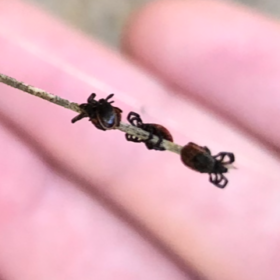If your trail is overgrown and thick with tall grasses (and most are thanks to a very wet Spring this year) … then you need to be aware of TICK HITCHHIKERS…



Unlike their highway counterpart these tick free riders don’t ask, they just grab on as you, your pet (or your horse) pass by. They perch quietly on the grasses and weeds that line your trail or backyard patiently waiting for their next unsuspecting host (and likely meal).
All too easily, you end up taking home a few uninvited guests and if not careful about checking and removing these pests when you return home, you could also end up inviting possible infection into your home.
Ticks carry Lyme disease and many other related infections that can cause debilitating and lasting symptoms. Tick incidence is on the rise almost everywhere, in part due to climate change and wetter, milder winters. If you enjoy the outdoors, you need to be aware of these itinerant nuisances and you need to take precautions to stay safe…
 Sunday, August 26th is
Sunday, August 26th is  Just six months ago, Bay Area Lyme launched a
Just six months ago, Bay Area Lyme launched a  The following is a post from a guest author,
The following is a post from a guest author,  By Dr. Michael Sterns, DVM,
By Dr. Michael Sterns, DVM,